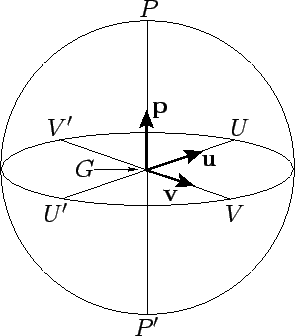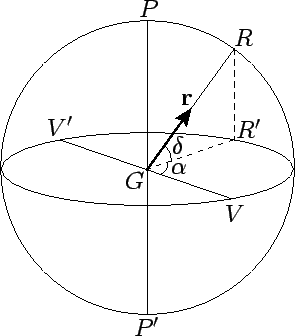 |
 |
The celestial equator, ![]() , is the intersection of the earth's equatorial plane with the celestial
sphere, and is therefore
perpendicular to the celestial axis. The so-called vernal equinox,
, is the intersection of the earth's equatorial plane with the celestial
sphere, and is therefore
perpendicular to the celestial axis. The so-called vernal equinox, ![]() , is a particular point on the
celestial equator that is used as the origin of celestial longitude. Furthermore, the autumnal equinox,
, is a particular point on the
celestial equator that is used as the origin of celestial longitude. Furthermore, the autumnal equinox, ![]() ,
is a point which lies directly opposite the vernal equinox on the celestial equator. Let the line
,
is a point which lies directly opposite the vernal equinox on the celestial equator. Let the line ![]() lie in the plane of the celestial equator
such that it is perpendicular to
lie in the plane of the celestial equator
such that it is perpendicular to ![]() , as shown in the figure.
, as shown in the figure.
It is helpful to define three, right-handed, mutually perpendicular, unit vectors: ![]() ,
,
![]() , and
, and ![]() .
Here,
.
Here, ![]() is directed from the earth to the vernal
equinox,
is directed from the earth to the vernal
equinox, ![]() from the earth to point
from the earth to point ![]() , and
, and ![]() from the
earth to the north celestial pole--see Fig. 3.
from the
earth to the north celestial pole--see Fig. 3.
 |
Consider a general celestial object, ![]() --see Fig. 4. The location of
--see Fig. 4. The location of ![]() on the celestial sphere
is conveniently specified by two angular coordinates,
on the celestial sphere
is conveniently specified by two angular coordinates, ![]() and
and ![]() . Let
. Let ![]() be the
projection of
be the
projection of ![]() onto the equatorial plane. The coordinate
onto the equatorial plane. The coordinate ![]() , which is known as declination, is the angle subtended between
, which is known as declination, is the angle subtended between ![]() and
and ![]() . Objects north of the celestial equator have positive
declinations, and vice versa. It follows that objects on the celestial equator have declinations of
. Objects north of the celestial equator have positive
declinations, and vice versa. It follows that objects on the celestial equator have declinations of ![]() ,
whereas the north and south celestial poles have declinations of
,
whereas the north and south celestial poles have declinations of ![]() and
and ![]() , respectively.
The coordinate
, respectively.
The coordinate ![]() , which is known as right ascension, is the angle subtended between
, which is known as right ascension, is the angle subtended between
![]() and
and ![]() . Right ascension increases from west to east (i.e., in the opposite direction to the
celestial sphere's diurnal rotation). Thus, the vernal and autumnal equinoxes have right ascensions of
. Right ascension increases from west to east (i.e., in the opposite direction to the
celestial sphere's diurnal rotation). Thus, the vernal and autumnal equinoxes have right ascensions of ![]() and
and ![]() , respectively. Note that
, respectively. Note that ![]() lies in the range
lies in the range ![]() to
to
![]() . Right ascension is sometimes measured in hours, instead of degrees, with one hour corresponding to
. Right ascension is sometimes measured in hours, instead of degrees, with one hour corresponding to
![]() (since it takes 24 hours for the celestial sphere to complete
one diurnal rotation). In this scheme, the vernal and autumnal equinoxes
have right ascensions of
(since it takes 24 hours for the celestial sphere to complete
one diurnal rotation). In this scheme, the vernal and autumnal equinoxes
have right ascensions of ![]() hrs. and
hrs. and ![]() hrs., respectively. Moreover,
hrs., respectively. Moreover, ![]() lies in the
range
lies in the
range ![]() to 24 hrs. (Incidentally, in this treatise,
to 24 hrs. (Incidentally, in this treatise, ![]() is measured
relative to the mean equinox at date, unless otherwise specified.)
Finally, let
is measured
relative to the mean equinox at date, unless otherwise specified.)
Finally, let ![]() be a unit vector which is directed from the earth to
be a unit vector which is directed from the earth to ![]() --see Fig. 4. It is easily
demonstrated that
--see Fig. 4. It is easily
demonstrated that